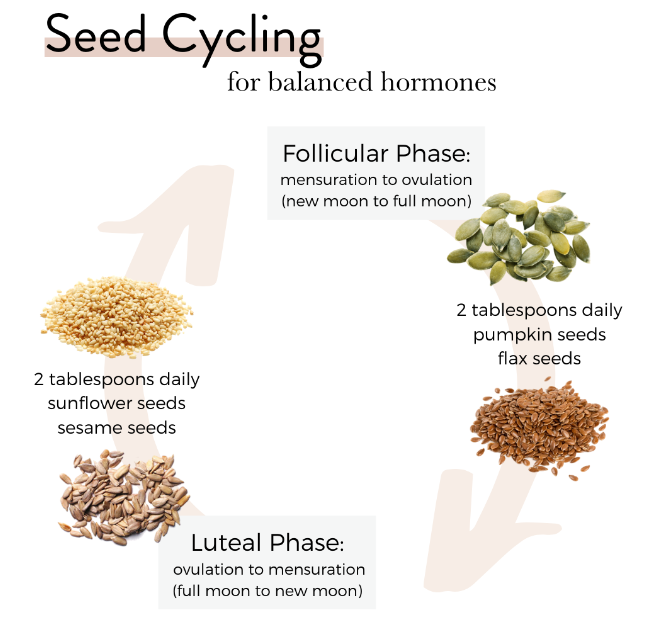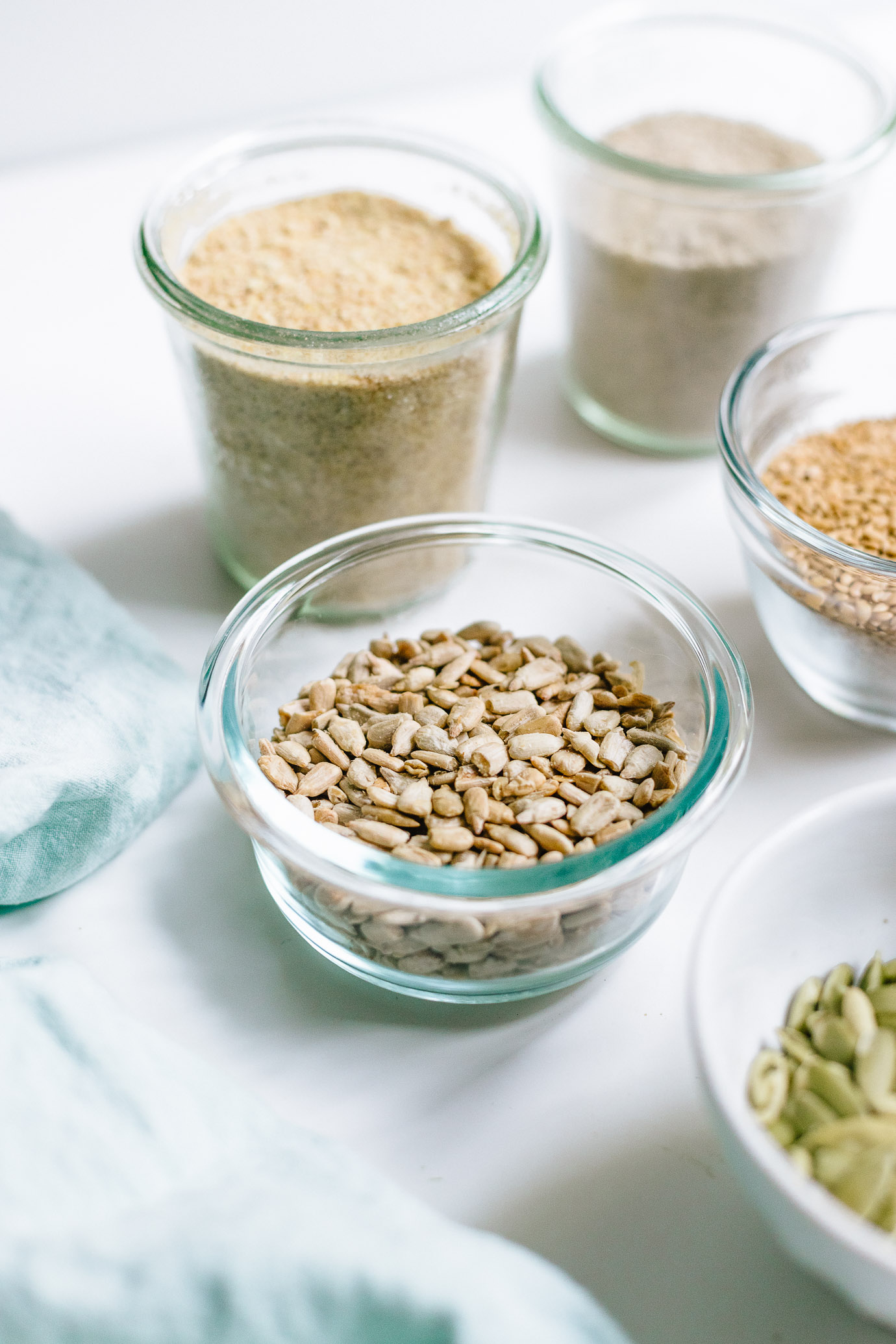dr. emily doctor
hey there! I'm
As a weight management doctor, my goal is to educate, empower and inspire my patients to achieve optimal health through integrating evidence based medicine with emotional and lifestyle support.
about me
weekday meal plans
grab the free guide
download guide
Seed cycling is the practice of eating specific seeds during the two main phases of your menstrual cycle (follicular and luteal) to help promote the healthy balance of estrogen and progesterone levels. It’s a gentle and completely natural way to reduce PMS symptoms, boost fertility, and can help stimulate menstruation if it’s absent (amenorrhea), and other symptoms as a result of hormonal imbalances.
Seed cycling can be used at any stage of a woman’s life (including post-menopause). However, it’s especially beneficial when coming off of hormonal birth control or struggling with post-birth control syndrome symptoms like acne, irregular periods or missing periods, or PMS
HOW TO START SEED CYCLING FOR HORMONE BALANCE?
Seed cycling is quite simple. You incorporate 1-2 tbsps of pumpkin and flax seeds daily during the follicular of your cycle. Once you ovulate, you incorporate sunflower and sesame seeds daily during your luteal phase.
DAYS 1-14 OF YOUR CYCLE (OR MENSTRUATION TO OVULATION)
- 1-2 tablespoons ground flax seeds
- 1-2 tablespoons ground pumpkin seeds
DAYS 15-28 OF YOUR CYCLE (OR OVULATION TO MENSTRUATION)
- 1-2 tablespoons ground sunflower seeds
- 1-2 tablespoons ground sesame seeds
If you don’t have a 28-day menstrual cycle, don’t worry! Many women don’t. It’s best to follow the 14 day cycle for each phase of seeds. By staying on track with the 2-week rotation, the process will nudge your body into an optimal menstrual cycle rhythm and help you get back on track.

WHAT IF YOU HAVE AN IRREGULAR OR MISSING PERIOD (AMENORRHEA)?
It’s possible to incorporate seed cycling even if you have irregular or missing periods. Instead of rotating with the phases of your cycling, you’ll follow the phases of the moon as a general guideline.
MOON PHASES SEED CYCLING GUIDELINES
- Days 1-14 (new moon to full moon), eat pumpkin seeds and flax seeds.
- Days 15-28 (full moon to new moon), eat sunflower seeds and sesame seeds.
It may seem odd or even a little woo-woo, but the moon is powerful. It controls the waves in the ocean, can affect our center of gravity, and have an effect on your menstrual cycle. Have you ever noticed that the moon and the average menstrual cycle are both 28 days? This is no coincidence. Many women’s cycles (when balanced) naturally follow the phases of the moon.
FOLLICULAR PHASE
During the first phase of the menstrual cycle (follicular phase), pumpkin seeds and flax seeds help improve our estrogen levels while preventing excess estrogen. Flax seeds contain lignans which bind to excess estrogen. Pumpkin seeds are high in zinc which helps support progesterone production as you move towards the progesterone rise in the second phase of your cycle.
LUTEAL PHASE
During the second phase of your cycle (luteal phase), sesame seeds and sunflower seeds help boost progesterone production. Sesame seeds are a rich source of zinc which help boost progesterone production and also contain lignans that help block excess estrogen while progesterone rises. Sunflower seeds are high in vitamin E and selenium. Vitamin E can help boost progesterone production, while selenium helps detox the liver of excess estrogen.
THE NUTRITIONAL COMPONENTS IN SEEDS
LIGNANS
Flax seeds are considered phytoestrogens, which have a weak estrogen-like effect in the body. (1) This naturally supports healthy estrogen production. Flax seeds are unique in that they also contain nutritional components called lignans which can help to bind excess estrogen. (2) Research shows that flax seeds help in lengthening the luteal phase, improving ovulation and reducing common PMS symptoms such as breast pain and cramping. (3)
Sesame seeds also contain lignans which help to block excess estrogen during the second phase of your menstrual cycle when progesterone rises. Research shows that sesame seeds are beneficial for postmenopausal women by improving blood lipids, antioxidants, and sex hormones. (4)
ZINC
Pumpkin and sesame seeds both contain high levels of zinc. This mineral helps to improve the formation of the corpus luteum in the uterus. The corpus luteum is responsible for producing progesterone and stimulates the uterus to thicken in preparation for potential implantation. (5) (6)
OMEGA-3S, OMEGA-6S + VITAMIN E
Both flax and pumpkin seeds are rich in omega-3 fatty acids. Omega-3s promote blood flow to the uterus, increase progesterone secretion, and help maintain healthy cell membranes. (7) In addition, Vitamin E has been linked to reducing PMS symptoms. (8) Research also shows that Vitamin E, omega-3s and omega-6s found in pumpkin, sesame, sunflower, and flax seeds are essential for hormone production and follicle function.
SELENIUM
Sunflower seeds, high in the trace mineral selenium, supports estrogen detoxification in the liver. (9) (2) This helps reduce excess estrogen during the luteal phase when estrogen declines and progesterone rises.
HOW TO INCORPORATE SEED CYCLING INTO YOUR EVERYDAY ROUTINE:
It’s recommended to eat 1-2 tablespoons of the specific seeds each day. Raw, ground seeds are best, especially for the flax and sesame. You can simply use a coffee/spice grinder to grind the seeds. I grind about a cup at a time and keep it in a glass jar in the fridge or freezer.
Think of your seeds like hormone balancing sprinkles. You can add them to anything! If you’re looking for ways to incorporate your seeds, here’s some ideas to get you started.
Some creative ways to use your seed cycling seed mix include:
- Add to smoothies, yogurt, oatmeal or chia seed pudding
- Sprinkle on toast, nourish bowls, salads or soups
- Homemade seed butter
- This recipe for seed cycling bites for each phase of your cycle
Seed cycling takes time to work with your body. It can take at least three months of daily use to start noticing the benefits. Keeping a journal to track your symptoms throughout the month can help you identify the shifts happening over the months.
SEED CYCLING

Leave a Reply Cancel reply
"As always...you are my weight loss angel - I did what you suggested and have lost two pounds since making the diet changes you suggested. I am down 20.5 lbs in 5.5 weeks! I am so grateful for you. You really are changing lives (including mine!)"
view next testimonial
what clients are saying...
"I can't tell you what a godsend Emily has been hitting the nail on the head that it's more psychological than physical hunger. Thank you for providing me the tools and knowledge to find a solution that makes me look and feel my very best!"
view next testimonial
what clients are saying...
"Emily's performance is outstanding in every way. Experience, knowledge, listening and coming up with solutions. What else could I add? Oh yes, her humble smile. Keep up your good work Dr. Doctor, I believe you make a lot of people feel better."
what clients are saying...
view next testimonial
copyright © 2022 emily doctor | Disclaimer | terms & conditions | Privacy Policy | COOKIE POLICY | site design by gt studio